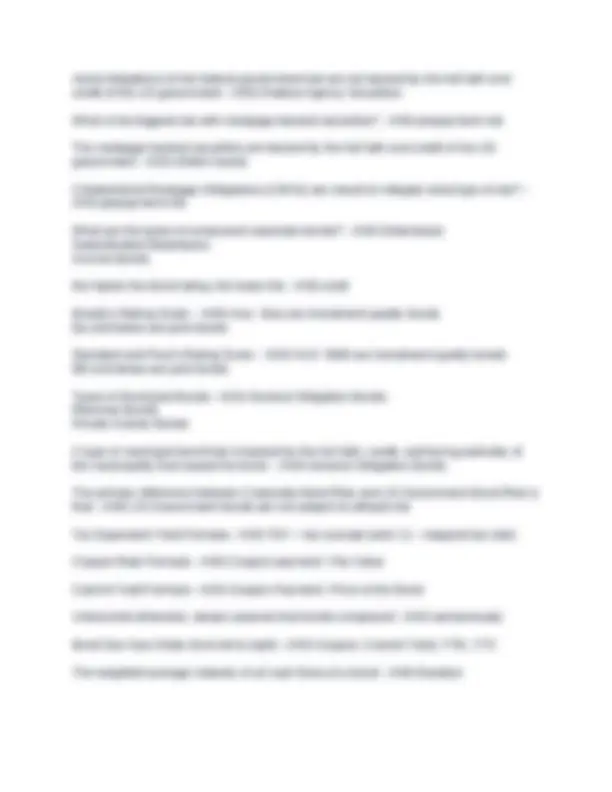








Study with the several resources on Docsity

Earn points by helping other students or get them with a premium plan


Prepare for your exams
Study with the several resources on Docsity

Earn points to download
Earn points by helping other students or get them with a premium plan
Community
Ask the community for help and clear up your study doubts
Discover the best universities in your country according to Docsity users
Free resources
Download our free guides on studying techniques, anxiety management strategies, and thesis advice from Docsity tutors
CFP Exam Investment Planning Questions and Answers
Typology: Exams
1 / 11

This page cannot be seen from the preview
Don't miss anything!







Type of underwriting where the underwriter agrees to sell as much of the offering as possible - ANS-Best efforts Type of underwriting where the underwriter agrees to buy the entire issuance of stock from the company - ANS-Firm Commitment A preliminary prospectus issued before SEC approval - ANS-Red Herring An annual report of financial statements filed with the SEC that is audited - ANS-10k A quarterly report of financial statements filed with the SEC that is not audited - ANS- 10Q Regulation T sets the initial margin requirement at - ANS-50% Margin Call formula - ANS-Loan / (1 - Maintenance Margin) A research report that ranks stocks where 1 represents the highest rating (buy) and 5 represents the lowest rating (sell) - ANS-Value Line A research report that ranks mutual funds where 1 represents the lowest rating (sell) and 5 represents the highest rating (buy) - ANS-Morningstar Who are dividends declared by - ANS-the Board of Directors How often are dividends typically paid - ANS-quarterly The date the stock trades without the dividend - ANS-Ed-Dividend Date The date on which you must be a registered shareholder in order to receive the dividend
-Regulates the issuance of new securities -Requires new issues are accompanied with a prospectus - ANS-Securities Act of 1933 -Regulates the secondary market and trading of securities -Created the SEC - ANS-Securities Act of 1934 -Authorized the SEC to regulate investment companies -Required investment advisors to register with the SEC or state - ANS-Investment Company Act of 1940 -Established SIPC
Provides that people value gains and losses differently and will base their decision on perceived gains rather than perceived losses - ANS-Prospect Theory Giving too much weight to recent observations or stimuli - ANS-Recency Bias You give yourself credit for all the goof outcomes and any bad outcomes are due to outside factors - ANS-Self-Attribution Bias Used when a decision or judgement is made when an apparently similar situation occurs even though the situations may have very different outcomes - ANS-Similarity Heuristic 1, 2, and 3 standard deviation percentages away from the mean - ANS-68%, 95%, 99% High peak and fat tails on a bell curve distribution chart - ANS-Leptokurtic Low peak and thin tails on a bell curve distribution chart - ANS-Platykurtic A spreadsheet simulation that gives a probabilistic distribution of events occurring. For example, what is the probability of running out of money in retirement with a client who has a withdrawal rate of 3%, 4%, or 5%? The simulation then adjusts assumptions and returns the probability of an event occurring depending upon the assumption. - ANS- Monte Carlo Simulation Correlation ranges from - ANS--1 to + A correlation of +1 denotes that the two assets are - ANS-perfectly positively correlated A correlation of -1 denotes that the two assets are - ANS-perfectly negatively correlated For correlation, diversification begins anytime correlation is - ANS-less than 1 A measure of an individual security's volatility relative to that of the market. It is used to measure the volatility of a diversified portfolio - ANS-Beta Beta formula - ANS-security risk premium / market risk premium List the systematic risks: - ANS-Purchasing Power Risk Reinvestment Rate Risk Interest Rate Risk Market Risk Exchange Rate Risk List the unsystematic risks: - ANS-Accounting Risk Business Risk
Country Risk Default Risk Executive Risk Financial Risk Government/Regulation Risk No portfolio that lies on the ____________________ is better than any other portfolio that also lies on it - ANS-Efficient Frontier The area above the efficient frontier is considered - ANS-unattainable Specifies the relationship between risk and return in all possible portfolios - ANS-Capital Market Line What measure of risk does the Capital Market Line use? - ANS-standard deviation Calculates the relationship of risk and return of an individual security using the Beta (b) as its measure of risk - ANS-Capital Asset Pricing Model Provides a measure of portfolio performance using a risk-adjusted measure that standardizes returns for their variability - ANS-Sharpe Index If the exam doesn't give you r-squared, then select - ANS-Sharpe Holding Period Return formula: - ANS-(selling price - purchase price +/- cashflows) / purchase price or equity invested The geometric average, or geometric mean, is a _________________________ compounded rate of return - ANS-time-weighted If Net Present Value is zero, then - ANS-yes, make the investment Net Present value formula: - ANS-PV of cash flows - initial cost Mutual funds report on a _____________ basis - ANS-time-weighted
Historical information will not help investors achieve above average market returns. Rejects technical analysis and asserts that fundamental analysis will help an investor achieve above average returns - ANS-Weak Form Asserts that both historical and public information will not help investors achieve above average market returns. Rejects both technical and fundamental analysis but inside information will lead to above average market returns. - ANS-Semi-strong form Asserts that historical, public, and private information will not help investors achieve above average market returns. Stock prices reflect all available information and react immediately to any new information. - ANS-Strong Form Market anomalies do not support - ANS-the efficient market hypothesis in any of the three forms Strategic asset allocation is an ________ allocation strategy - ANS-active tactical asset allocation is a _______ allocation strategy - ANS-active At what levels are US Treasury securities nontaxable? - ANS-state and local Nonmarketable US Treasury Securities: - ANS-Series EE/E Bonds Series HH/H Bonds Series I Bonds Marketable US Treasury Issues that have maturities of less than 1 year - ANS-US Treasury Bills Marketable US Treasury Issues that have maturities of 2-10 years - ANS-US Treasury Notes Marketable US Treasury Issues that have maturities of greater than 10 years - ANS-US Treasury Bonds A bond issues at a discount from par value - ANS-Original Issue Discount (OID) the principal/par value adjusts for inflation and, then, the coupon rate is applied to the new principal amount. The coupon rate does not change. - ANS-Treasury Inflation Protected Securities (TIPS) These treasury securities create zero coupon bonds. They are highly liquid and appropriate for for investors looking for a low risk, highly liquid investment, with a specific time horizon - ANS-Separate Trading of Registered Interest and Principal Securities (STRIPS)
moral obligations of the federal government but are not backed by the full faith and credit of the US government - ANS-Federal Agency Securities What is the biggest risk with mortgage-backed securities? - ANS-prepayment risk The mortgage backed securities are backed by the full faith and credit of the US government - ANS-GNMA bonds Collateralized Mortgage Obligations (CMOs) are meant to mitigate what type of risk? - ANS-prepayment risk What are the types of unsecured corporate bonds? - ANS-Debentures Subordinated Debentures Income Bonds the higher the bond rating, the lower the - ANS-yield Moody's Rating Scale: - ANS-Aaa - Baa are investment quality bonds Ba and below are junk bonds Standard and Poor's Rating Scale: - ANS-AAA- BBB are investment quality bonds BB and below are junk bonds Types of Municipal Bonds - ANS-General Obligation Bonds Revenue Bonds Private Activity Bonds A type of municipal bond that is backed by the full faith, credit, and taxing authority of the municipality that issued the bond. - ANS-General Obligation Bonds The primary difference between Corporate Bond Risk and US Government Bond Risk is that - ANS-US Government bonds are not subject to default risk Tax Equivalent Yield Formula - ANS-TEY = tax exempt yield / (1 - marginal tax rate) Coupon Rate Formula - ANS-Coupon payment / Par Value Current Yield Formula - ANS-Coupon Payment / Price of the Bond Unless told otherwise, always assume that bonds compound - ANS-semiannually Bond See Saw Order (from let to right) - ANS-Coupon, Current Yield, YTM, YTC The weighted average maturity of all cash flows of a bond - ANS-Duration
These shares have a front-end load and a small 12b-1 fee - ANS-A Shares These shares have a back-end sales load and a high 12b-1 fee - ANS-B Shares These shares do not charge a front-end load, but they charge a small back-end load and charge the maximum 12b-1 fee of 1%. They are most appropriate for short term investors. - ANS-C Shares What are the three types of REITs? - ANS-Equity Mortgage Hybrid These represent foreign stock held in domestic banks' foreign branch. They trade on US exchanges and are denominated in US dollars. - ANS-American Depository Receipts (ADRs) ADRs do not eliminate __________ risk - ANS-exchange rate Which option will provide you with the maximum gains if the stock price appreciates? - ANS-buying a call Which option will provide you with the maximum gains if the stock price falls? - ANS- buying a put Intrinsic value of a call option: - ANS-Stock price - Strike price Intrinsic value of a put option: - ANS-Strike price - Stock price Time Value of an option: - ANS-Premium - Intrinsic Value Intrinsic value of an option cannot be less than - ANS-zero Option strategy that involves selling call options on stock that is currently owned by the investor - ANS-Covered Call Option strategy that involves buying a put option on a stock that is currently owned by the investor. - ANS-Married Putt When asked which options strategy "protects profits" or "locks in gains" the answer is always - ANS-buy a put Option strategy that involves buying a call and a put on the same stock - ANS-Long Straddle
Option strategy that involves selling a call and a put on the same stock - ANS-Short Straddle Options pricing model used to determine the value of a call option - ANS-Black/Scholes Attempts to value a put option based on the value of a corresponding call option - ANS- Put/Call Parity Attempts to value an option based on the assumption that a stock can only move in one of two directions - ANS-Binomial Pricing Model What are the variables considered in the Black/Scholes Pricing Model? - ANS-Current price of the underlying asset Time until expiration The risk-free rate of return volatility of the underlying asset If a call option lapses or expires, then the premium paid is a _____________ and the premium received is a ____________ - ANS-short term loss short term gain If a put option expires without being exercised, the premium paid is a ____________ and the premium received is a _____________ - ANS-short term loss short term gain Essentially work the same way as call options, are issued by corporations, and have maturities of 5-10 years - ANS-Warrants Options contracts give the holder the _______ to do something; futures contracts ___________ the holder to make or take delivery of the underlying asset - ANS-right oblige